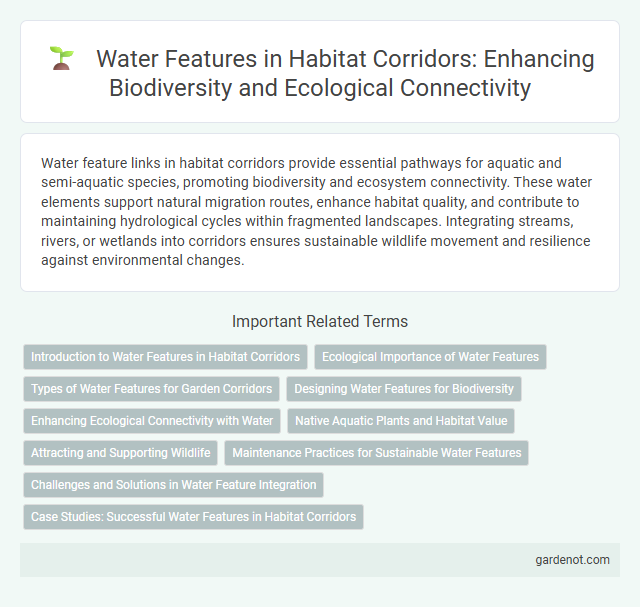Water feature links in habitat corridors provide essential pathways for aquatic and semi-aquatic species, promoting biodiversity and ecosystem connectivity. These water elements support natural migration routes, enhance habitat quality, and contribute to maintaining hydrological cycles within fragmented landscapes. Integrating streams, rivers, or wetlands into corridors ensures sustainable wildlife movement and resilience against environmental changes.
Introduction to Water Features in Habitat Corridors
Water features in habitat corridors create essential aquatic habitats that support biodiversity and promote wildlife movement. Integrating streams, ponds, or wetlands enhances ecological connectivity by providing hydration, breeding grounds, and food sources for various species. These aquatic elements improve environmental quality and resilience, fostering sustainable ecosystems within habitat corridors.
Ecological Importance of Water Features
Water features within habitat corridors play a crucial role in maintaining biodiversity by providing essential resources such as drinking water and breeding grounds for aquatic and terrestrial species. These links support ecosystem functions like nutrient cycling and microclimate regulation, enhancing habitat quality and connectivity. The presence of streams, ponds, and wetlands fosters species dispersal and genetic exchange, which is vital for population resilience and ecological stability.
Types of Water Features for Garden Corridors
Water features for garden corridors include streams, ponds, and rain gardens that support biodiversity by providing hydration and habitat for wildlife. Constructed wetlands and small waterfalls enhance ecological connectivity while aiding in water purification and nutrient cycling. Selecting native aquatic plants alongside these water features promotes native fauna and maintains natural ecosystem balance within habitat corridors.
Designing Water Features for Biodiversity
Designing water features for biodiversity involves creating interconnected aquatic habitats that support diverse species and enhance ecosystem health. Incorporating native plants, varied depths, and natural substrates encourages amphibians, insects, and birds to thrive within habitat corridors. Effective water feature links facilitate species movement, genetic exchange, and resilience against environmental changes.
Enhancing Ecological Connectivity with Water
Water feature links play a crucial role in enhancing ecological connectivity by providing continuous aquatic habitats that support diverse species movement and genetic exchange. Riparian corridors along streams and rivers serve as vital pathways for wildlife, enabling migration and access to essential resources while maintaining ecosystem integrity. Effective management of these water-based corridors fosters biodiversity resilience and strengthens landscape-scale ecological networks.
Native Aquatic Plants and Habitat Value
Native aquatic plants in water feature links enhance habitat corridors by providing essential food, shelter, and breeding grounds for diverse wildlife species. These plants improve water quality by filtering pollutants and stabilizing sediments, which supports a healthier aquatic ecosystem. Integrating native vegetation in water features boosts biodiversity and strengthens ecological connectivity within habitat corridors.
Attracting and Supporting Wildlife
Water feature links in habitat corridors create essential resources that attract diverse wildlife by providing reliable hydration and breeding grounds. These aquatic habitats support amphibians, birds, and mammals, promoting biodiversity and enabling species to move safely between fragmented ecosystems. Maintaining clean, natural water sources within corridors enhances resilience and stability of wildlife populations.
Maintenance Practices for Sustainable Water Features
Regular maintenance of water features within habitat corridors ensures ecological balance and promotes biodiversity by preventing algae overgrowth and sediment buildup. Implementing eco-friendly cleaning methods, such as manual debris removal and natural filtration systems, supports water quality without harming local flora and fauna. Periodic inspection of pumps, liners, and vegetation safeguards sustainable water flow and habitat connectivity essential for wildlife movement.
Challenges and Solutions in Water Feature Integration
Water feature integration in habitat corridors faces challenges such as maintaining water quality, preventing habitat fragmentation, and ensuring connectivity for aquatic species. Solutions include implementing natural filtration systems, designing wildlife-friendly water crossings, and restoring riparian buffers to enhance ecosystem resilience. Incorporating adaptive management strategies allows continuous monitoring and mitigation of water-related impacts on habitat connectivity.
Case Studies: Successful Water Features in Habitat Corridors
Effective water features in habitat corridors enhance biodiversity by providing essential hydration and breeding grounds for wildlife. Case studies from the Chesapeake Bay watershed demonstrate how constructed wetlands and riparian buffers improve water quality while supporting amphibian and bird populations. The Poudre River corridor in Colorado highlights the restoration of natural stream flows, facilitating migratory fish passage and increasing habitat connectivity.
Water feature link Infographic

 gardenot.com
gardenot.com